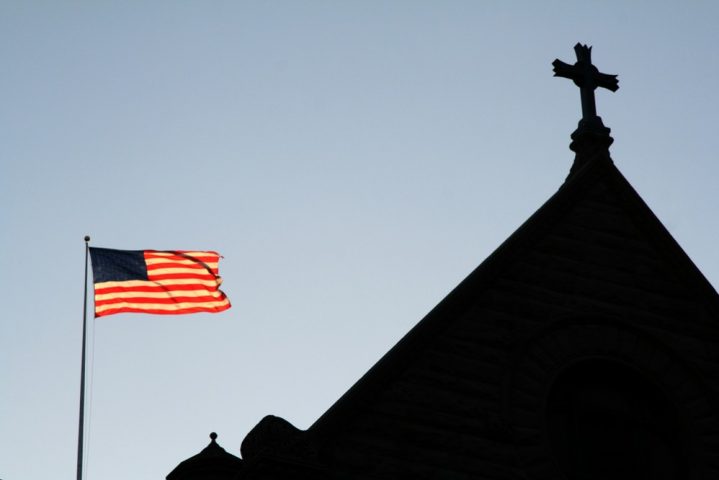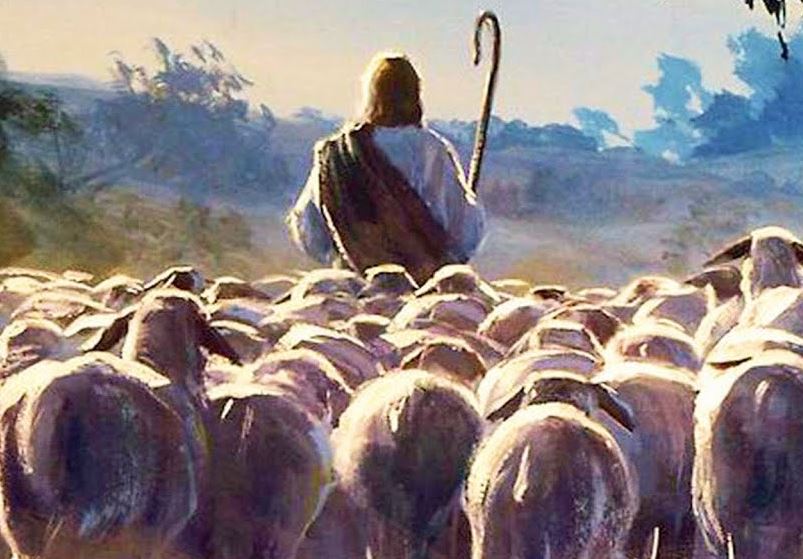There is a strain of thought one encounters with some frequency: namely, that the First Amendment to the US Constitution—by virtue of prohibiting religious establishment and protecting the individual right to free exercise—banishes religion from the public realm and assigns it exclusively to the sphere of personal belief. In other words, the First Amendment kicked religion out of American politics.
According to theologian Oliver O’Donovan, for example,
The development of the modern doctrine [of the separation of church and state] was associated with the sceptical conviction of the Enlightenment that religious questions were not open to public arbitration . . . The First Amendment to the United States Constitution, prohibiting the “establishment” and protecting the “free exercise” of religion, is the paradigm assertion of this doctrine, and so can usefully be taken as the symbolic end of Christendom.
O’Donovan recognizes that that the separation of church and state could be understood in a way acceptable to “the most traditional apologist for dual jurisdiction in Christendom.” But that understanding is not captured in the First Amendment. Though formulated “largely by Christians who thought they had the interests of the church’s mission at heart” and who argued for it “on theological grounds,” the amendment nevertheless “bears the marks of the Age of Revolution” (p. 244 here).
Likewise, Brad S. Gregory says that “In principle, the American right to individual religious freedom opens the way to secularization. By construing religion narrowly, it separates religion from the rest of life. Individuals can simply choose or not to be religious.” According to Gregory, Thomas Jefferson’s understanding of religious liberty embodies this modernist, secularizing view: “Jefferson thinks it doesn’t matter what you believe so long as it isn’t publicly disruptive or damaging.” In support of this claim he cites Jefferson’s Notes on the State of Virginia: “It does me no injury for my neighbor to say there are twenty gods, or no god. It neither picks my pocket nor breaks my leg.” Secularization doesn’t play out right away. “Because Americans continue to hold in common so many religious views, as well as moral convictions derived from them, the American disestablishment of religion in the late eighteenth and early nineteenth centuries works for quite some time.” But Gregory clearly holds that American disestablishment of religion embodies Jefferson’s account of religious liberty—and that this account is a modernist and secularizing repudiation of Christianity rightly understood (pp. 240-2, here).
Similarly, Rod Dreher has recently claimed that the US Constitution is “a Lockean document” that “privatizes religion, separating it from the state.” He continues:
religious tolerance . . . laid the groundwork for excluding religion from the public square by making it a matter of private, individual choice. In the American order, the state’s role is simply to act as a referee among individuals and factions. The government has no ultimate conception of the good, and it regards its own role as limited to protecting the rights of individuals (p. 36 here).
The argument that the Constitution privatizes religion by separating it from the state and that religious toleration privatizes religion presupposes a certain narrative and makes some problematic conceptual assumptions.
The First Amendment Did Not Privatize Religion—It Was About Federalism
As to the latter, this argument conflates the separation of church and state or of civil government and religious exercise with the separation of religion and politics. Even if the First Amendment—by prohibiting government infringement on free exercise and governmentally established churches—does separate the jurisdictions of church and state, it does not follow that it banishes religion from culture or public life. The jurisdictional separation of church and state effected by the First Amendment allows people to vote for religious reasons, to make religious arguments in order to persuade others to support particular candidates or policies, and allows political officials and legislators to act for religious reasons. Nothing in the jurisdictional separation of church and state entails or encourages the separation of religion and politics, much less of religion and public life.
Indeed, American culture, politics, and public life have always exhibited high levels of religious engagement and participation, particularly compared to other Western nations (including many with established churches). None of this is compatible with the claim that the First Amendment essentially privatizes or trivializes religion or that it effectively secularizes culture or public life. According to James Madison, religious disestablishment in Virginia led to significantly increased religious participation. Eminent historian Ralph Ketcham notes that Alexis de Tocqueville’s description of America in the 1830s confirms Madison’s observation. Tocqueville claimed, says Ketcham, that America enjoyed “greater religious vitality” and Christianity in America exercised greater influence on public life than in Europe because of disestablishment (see p. 49 here). Thus, Tocqueville writes, “In Europe, Christianity allowed itself to be intimately united with the powers of the earth. Today these powers are falling and Christianity is as though buried beneath their debris. It is a living thing that someone wanted to bind to the dead: cut the ties that hold it and it will rise again” (see Volume I, Part II, Chapter 9 here).
Originally, the first amendment simply prevented Congress from infringing religious exercise or making a law regarding religious establishment. That meant that Congress was forbidden to create a national church and to make any law with respect to state establishments. Congress could neither encourage nor discourage those establishments. Prior to the Supreme Court’s adoption of the doctrine of selective incorporation (in the very late nineteenth century and early decades of the twentieth), the First Amendment made clear that jurisdiction of this matter remained with each state and the people of each state (or, if the people of the state decided, with local government and the people of each local community). Thus, prior to selective incorporation, the First Amendment did not separate government and religion. Rather, it declared that the authority to establish an official religion—or not—rested with the people of each state, not the national government. In other words, the First Amendment was about federalism.
The Sacral Politics of the Ancient World
The deeper problem with this reading of the First Amendment and its effects is that it relies on a standard Enlightenment narrative that some rather gifted historians have been spent the past few decades dismantling (for instance, Francis Oakley here, here, and here). According to this secularist narrative, church and state (or religion and government) were joined at the hip during the medieval period. As a result of the wars of religion, modernity hit upon the solution of religious toleration and the separation of church and state. This separation ultimately sought the removal of religion from the public realm, in order to avoid the conflict and instability occasioned by religious disagreement. As I noted in a previous essay, this story flips the actual history almost exactly on its head. To see why, we must go back before the advent of Christianity.
In his famous chapter on civil religion in The Social Contract, Rousseau laments the way in which ancient Christianity sundered the political and religious unity of ancient political order. While Rousseau misunderstands ancient Christianity, he nevertheless is on to something.
As Francis Oakley argues (here and here), the ancient world was a sea of monarchy—in particular, sacral monarchy. Sacral monarchy involves two main components. First, at the height of the political order stands the king who is either divine, the son of a god, the special creation of a god, or the unique representative of a god. Second, the king exists to perform sacred rites necessary for the preservation of cosmic order. The king is society’s high priest. In sacral monarchy, the political and the religious are not only not separated; they are not even distinguished. The political exists to perform a religious function.
In the midst of a sea of sacral monarchies, the “republican parenthesis” occurred. Regimes that were not monarchies emerged in Greece and Italy. These republics, including Athens and Rome, however, preserved the long-established unity of political order and religious worship. It’s worth recalling that Athens and Rome both had goddesses named for them (Athena and Roma, respectively). Moreover, the gods worshiped within the polis were the gods of the polis. Thus, part of the indictment against Socrates included teaching other gods than those of the city. In ancient republics, religious worship and public order remained as intertwined as they were in sacral monarchy—so much so that we might coin the phrase sacral republicanism to describe the republican parenthesis in Italy and Greece. In other words, republics did not replace sacral monarchy with non-sacral, secular political order. Rather, they replaced one kind of sacral order with another. With the rise of empire in the Western world, however, sacral monarchy came roaring back to the fore. Roman emperors sought and obtained for themselves the title pontifex maximus.
The Rejection of Sacral Polity: The Christian Apostasy
In the heart of sacral empire, in which followers of Jesus of Nazareth were sometimes executed for refusing to participate in religious tribute to the emperor, Christianity conceived a new framing of the relation of political order and the worship of God. The very distinction between religious observance and government was a Christian innovation. In an early essay entitled “Kingship and the Gods: The Western Apostasy,” Oakley dubbed the utter uniqueness of Christianity’s utter rejection of the prevailing religious-political order “the Christian apostasy.”
Though unique, Christian apostasy has roots in Hebrew Scripture. The book of I Samuel not only inveighs against kingship, but also inveighs against King Saul for performing sacred rites the prophet Samuel asserts King Saul was forbidden to perform. Given that ancient kings existed in order to perform such rituals, this passage is stunning. Even more stunning is Christianity’s gradual but complete sundering of divine affairs from civil jurisdiction. In 494, Pope Gelasius I articulated the “two swords” doctrine: “There are two, august Emperor, by which this world is governed, the sacred authority [auctoritas] of priests and the royal power [potestas].” While Gelasius assigned the greater responsibility to priests (because they must answer to God for kings), his distinction and jurisdictional separation of sacred authority and political power—an outworking of the Christian gospel—radically reconceived the relation of the sacred and political order.
In the Fourth Tract of “On the Bond of Anathema,” issued against the emperor in 496, he went further still. There Gelasius held that kings “have only the power to judge temporal matters and have no competence in divine affairs.” Temporal rulers therefore have no right “to sit in judgment on those who administer the things of God.” He accurately describes the relation of government to the sacred in ancient political order and expressly rejects it on distinctly Christian grounds—Christ himself “distinguished between the offices of both powers according to their own proper activities and separate dignities.” Thus, “spiritual activity would be set apart from worldly encroachments and the ‘soldier of God’ (2 Tim 2:4) would not be involved in secular affairs, while on the other hand he who was involved in secular affairs would not seem to preside over divine matters.”
Gelasius grounds the shattering of the ancient unity of government and sacred observances in the advent of the Messiah and the Incarnation. Only in the Messiah is authority over the two spheres joined. In human communities, these distinct realms are to be administered by different individuals. Those who administer civil government lack competence and jurisdiction in divine affairs. Those who administer the church are subordinate to civil rule in temporal affairs.
Christianity and the American Project
Centuries later, James Madison would echo Gelasius, affirming the idea of a sphere of religious exercise that is “wholly exempt” from the “cognizance” and “authority” of both society and civil government. The reason that religion does not fall under the authority of society or government is because our “allegiance” to the “Universal Sovereign” comes before and is above all others.
Granted, Gelasius envisioned a sphere of divine affairs governed by the church, while Madison has in view dictates of conscience apprehended by each individual. Yet, insofar as Madison preserves a sphere not subject to civil jurisdiction and over which God is sovereign, he stands in the Gelasian tradition rather than the modern tradition. The modern doctrine of sovereignty advanced by Hobbes, for instance, rejected any realm not subject to the civil sovereign. In keeping with this doctrine Hobbes expressly rejects the notion of an inviolable realm of individual conscience: “Another doctrine repugnant to Civil Society, is that whatsoever a man does against his Conscience, is Sin” (see Chapter XXIX of Leviathan). Modernity sought to reunite under one power what Christianity had sundered. Robert Wilken has established that early Christianity affirmed a natural right to worship upon which civil authority could not rightly encroach. According to Tertullian (writing about 212), “It is a human law (humani iuris) and a natural right (naturalis potestatis) that one should worship whatever he intends (quod putaverit colere); the religious practice of one person neither harms nor helps another.” Jefferson himself copied this passage at the bottom of the page in his own copy of his “Notes on the State of Virginia” at Query 17, where he discusses religious liberty (the passage quoted above).
In short, the American understanding of a natural right to religious liberty, as the property of individuals and as something with which government ought not interfere, derives from Christian antiquity, as Jefferson eventually realized.
It was Christianity, not modernity, that separated church and state. It was modernity, not Christianity, that sought to bind them back together (thus the terms of the Treaty of Westphalia in 1648). And, at day’s end, the American order has more in keeping with the Christian apostasy than with either antiquity’s sacral political orders or modernity’s rejection of the claim that there exists any domain outside the jurisdiction of the modern state.
Paul R. DeHart is associate professor of political science at Texas State University. He is author of Uncovering the Constitution’s Moral Design (University of Missouri Press) and editor (with Carson Holloway) of Reason, Revelation, and the Civic Order: Political Philosophy and the Claims of Faith (Northern Illinois University Press).
http://www.thepublicdiscourse.com/2018/04/21381/







